by Elaine O'Brien
The words “feminist to the core” flash on the GIF of artist Suzanne Lacy in conversation. Created from a recent publicity interview for Suzanne Lacy: We Are Here, the first full retrospective of the artist’s work at Yerba Buena Center for the Arts (YBCA) and the San Francisco Museum of Modern Art (SFMOMA), the GIF mischaracterizes a wholly inclusive and multifarious new genre of public art production spanning nearly five decades.
The overwhelming evidence presented in this comprehensive exhibition – scores of well-documented and re-staged performances and installations on a range of social issues – makes Lacy’s snapshot of her art as essentially feminist perplexing. Her production has, from her first works in the early 1970s, been devoted to the empowerment of women, and the subject is a major theme of her retrospective. Nevertheless, what the exhibition, on view to August 4, makes clear is that the artist has always worked for equity for those relegated to the outskirts of power regardless of gender, age, class, race, ethnicity or nationality. Lacy’s “feminist to the core”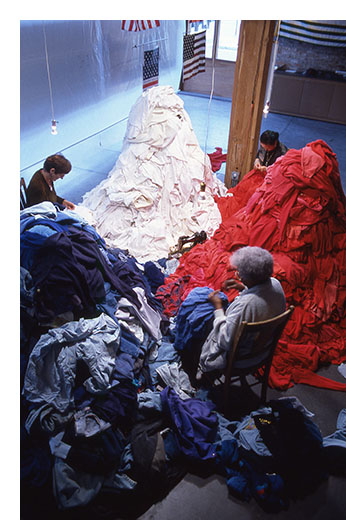
Based in Los Angeles with deep roots in the Bay Area, Lacy is an artist, teacher, and writer whose essays and pedagogy are an integral part of her artwork. She is a pioneer of an art genre that is now at the center of contemporary art production: the expanded field of post-studio practices referred to as socially engaged art, community-based art, relational art, participatory art, and most commonly, social practice. Born in 1945 in Wasco, California, a working-class town in the San Joaquin Valley, Lacy was doing graduate work in psychology at Fresno State when she joined Judy Chicago’s groundbreaking Feminist Art Program (FAP) in 1970. Chicago’s pedagogy relied on consciousness-raising sessions and immersive readings in women’s art history and feminist literature. In FAP, the dominant practice was performance art: a genre with dada anti-art connotations embraced by Lacy and other feminists and political activist artists.
Lacy was part of Second Wave feminism of the 1960s and 1970s that took up the objectives and strategies of that era’s Civil Rights Movements. “Our analysis was not limited to women,” she recalled in an interview, “it was extended to other areas of oppression.” To feminist and activist artists of color, the establishment’s definition of art was an exclusionary modernist myth is that secured the status quo for the establishment. Their shared agenda was to dismantle the old definition of art as objects made of traditional high art materials by white men in their studios for the appreciation of the privileged few in art spaces set apart from real life. The new forms of
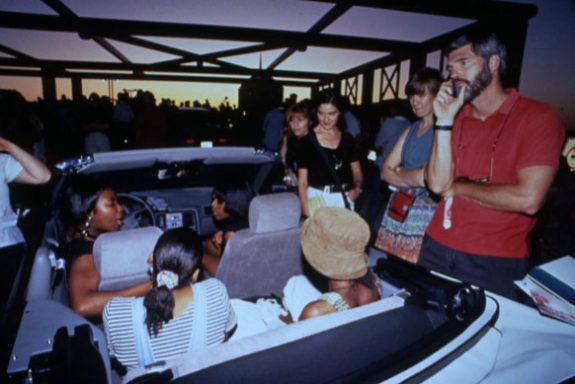
art made by Lacy and other socially engaged artists strategically expanded every tenet of the modernist definition of art – who makes it, what it’s made from, where, for whom and why it’s made. Until the early 1990s, social practice art like Lacy’s was still outside the mainstream; now it is a genre taught in most MFA programs and is a global phenomenon.
Suzanne Lacy: We Are Here is organized around seven overlapping themes – bodies, personas, violence against women, networks, image and dialogue, youth, work and class – that the artist has returned to over the years, re-contextualizing previous productions and creating new ones. On view at Yerba Buena are two ambitious multi-part projects focusing on issues of urban youth, work and class: themes relevant to the art center’s mission. The entry gallery highlights the currency of social practice art and Lacy’s legacy with wall displays by three local Bay Area youth arts and activist organizations: San Francisco–based Youth Speaks, Berkeley-founded Youth Radio and Oakland-based Center for Media Justice. The main YBCA gallery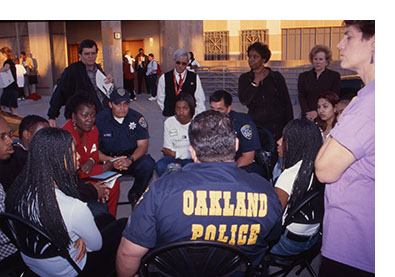
The seventh-floor galleries of SFMOMA present the rest of Lacy’s prodigious production from the early 1970s to the present. It’s an overwhelming experience. In the galleries farthest from the exhibition entrance (off the elevators) are artworks dealing with themes of the body and personas, along with the most disturbing of Lacy’s performances, those from the 1970s dealing with violence against women, the first of which is Ablutions (1972) with its unbearable recorded testimonies. The artist’s signature social practice begins with the Los Angeles Ariadne projects that she produced with Leslie Labowitz on a rape epidemic in Los Angeles and the sensational eroticization of it in mass media. Three Weeks in May (1977) with its wall-size rape map of Los
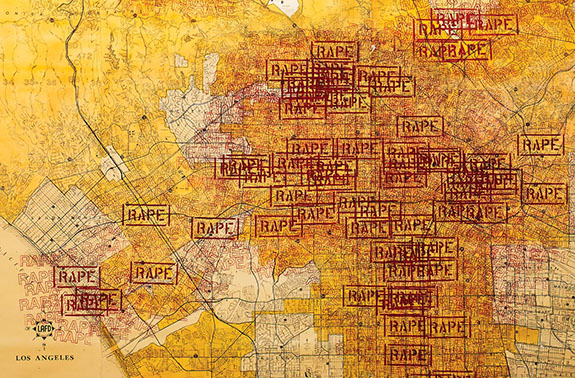
Angeles, and In Mourning and Rage (1977), the public ritual that produced stunning visuals for television and newspapers (and are reproduced in every contemporary art textbook), are still the most famous of Lacy’s works. The recent performance about violence against women, De tu puño y letra (By Your Own Hand) (2014-15/2019), is the most magnanimous and hope-inspiring. The three-part performance in the Plaza Belmonte bullring of Quito, Ecuador was a theatrical event performed by the people of Quito and designed to encourage collective and individual empathy in men about domestic violence. In the second of three acts, hundreds of men slowly fill the bullring, each reading aloud letters written by women about their experiences of violence. In the last act, the men read the letters to small groups of two or three audience members.
Another recent performance designed to bring together alienated groups is The Circle and the Square (2015-16), a project for the people of Pendle, England, a former textile mill town. Presented as a split-screen video projection, one half shows a performance of Sufi chanting, the other a performance of English shape-note singing. The singers are from groups of townspeople that became estranged after the mill closed. Lacy staged the three-day performance exclusively for the camera and sited it in the former Brierfield Mill – an enormous, minimalist space with fine light and color – where the performers and their families once worked. Rows of white chairs face center in a close concentric circle for a Sufi chant and a

square for shape-note singing, formations that create islands of intimacy within the immense room. The camera captures the unity of the singers and their faces in song. Each group’s performance is projected alternately on one half of the screen, after which the two are shown simultaneously. The participants’ evident joy in the singing and coming together on common ground is spiritual and utopian.
In the SFMOMA exhibition, the physical juxtaposition of works on the same theme across time dramatizes the chronological opening out of Lacy’s production from the early feminist body performances to the expanded field of social practice, increasing in scale, inclusion, diversity, intersectionality and collaboration. Collaborative creation is the signature feature of Lacy’s feminist-inspired theory and practice. The “we” in the exhibition title, We Are Here, underlines the importance of collaboration. Artists, community activists, media publicists, volunteers and participant performers, including primary and secondary audience members, are at once her
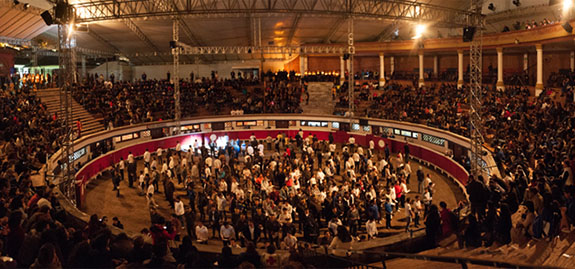
subjects and co-creators. The artist is present as the primary organizing force: director, facilitator, curator. Lacy’s singular energy has propelled thousands of people to make and collectively experience her art. “My challenge as an artist,” Lacy writes in her catalog acknowledgments, “is … to navigate that tenuous line connecting “my” and “our.” “It is a very complicated ‘we,’” she explained elsewhere, “but it is always a ‘we’ never an ‘I.’”
In the retrospective’s exhibition and catalog texts, Lacy is acknowledged as first in the list of major collaborators – on the same line, in the same font and size. Such radical decentering of authorship is unfamiliar and surprising in a monographic exhibition. It’s surprising because this exhibition is one of the first museum retrospectives of a social practice artist. The challenge for the YBCA and SFMOMA curatorial team – Rudolf Frieling, Lucía Sanromán and Dominic Willsdon – was to present a retrospective for an artist whose collaborative output was never meant to be seen in traditional art galleries.
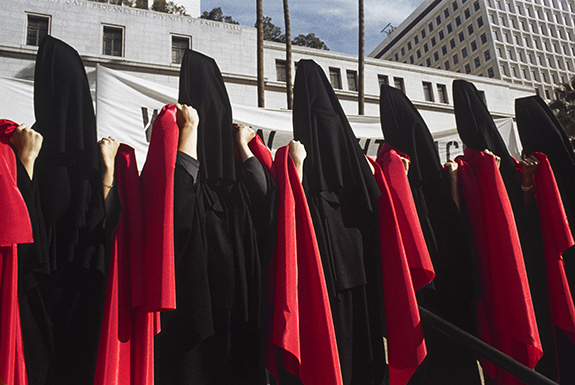
1977; performance, December 13, 1977, Los Angeles City Hall
Participatory projects and performances get their power from live encounters in particular locations. Museum installations cannot provide the raw experience of direct engagement. However, what museums do provide is invaluable: the time and place to see art at a critical distance, affording viewers the time to look, read and reflect. Suzanne Lacy: We Are Here offers an opportunity to evaluate nearly half a century of ambitious social practice as a whole. From that distance, the artist’s signature style can be recognized and described, as Dominic Willsdon does in his catalog essay, “Geometry in Motion.” Questions about collecting and securing Lacy’s work as a legacy can be asked, and strategies proposed, as they are in catalog essays by Sanromán and Frieling. The retrospective also makes it possible to trace Lacy’s aesthetic and philosophical trajectory from her twenties to her seventies and understand the expansive vision behind such works as The Roof is on Fire, The Circle and the Square and De tu puño y letra (By Your Own Hand), which take the experience of all people as their subjects.
# # #
“Suzanne Lacy: We Are Here” @ SFMOMA and YBCA through August 4, 2019.
About the author:
Elaine O'Brien is a professor of modern and contemporary art at Sacramento State University. Dr. O’Brien has lectured regionally, nationally and internationally on topics in global modern and contemporary art. She is the editor of the anthology, Modern Art in Africa, Asia, and Latin America: An Introduction to Global Modernisms, distributed internationally. Her current research is for a book about art produced in Northern California in the 1960s and 1970s in the context of that era’s sociopolitical revolutions and shift from the modern to the postmodern.
Great review, very impressive reporting. I love this website very important for our art community. Thanks Simon